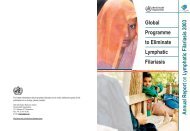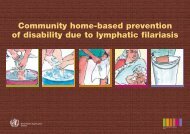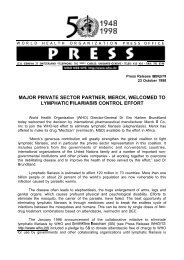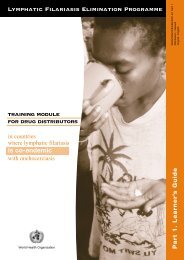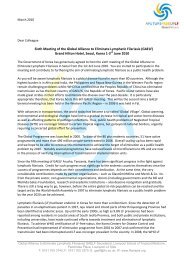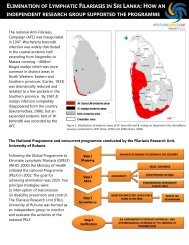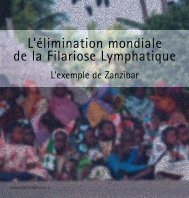English - Global Alliance to Eliminate Lymphatic Filariasis
English - Global Alliance to Eliminate Lymphatic Filariasis
English - Global Alliance to Eliminate Lymphatic Filariasis
Create successful ePaper yourself
Turn your PDF publications into a flip-book with our unique Google optimized e-Paper software.
REPORT OF THE 6 TH GAELF MEETING, JUNE 2010<br />
data suggested that transmission had<br />
been interrupted, so MDA was halted and<br />
post-MDA surveillance was initiated. The<br />
goal of this surveillance is <strong>to</strong> ensure that<br />
there is no ongoing LF transmission and <strong>to</strong><br />
prevent re-introduction through prompt<br />
case detection and response. The<br />
surveillance system is low-cost and has<br />
been integrated as much as possible with<br />
other health activities. It has several<br />
components. First, areas that were<br />
excluded from MDA on the basis of initial<br />
mapping are being re-mapped in 2010,<br />
using the RAG-FIL method with a finer grid<br />
(e.g., 10 or 35 km) than<br />
was used initially (50<br />
km). Second, surveys<br />
were done in two<br />
districts in 2009 <strong>to</strong><br />
determine whether <strong>to</strong><br />
s<strong>to</strong>p MDA; these<br />
provided a baseline<br />
for post-MDA<br />
surveillance. In these<br />
surveys, 1548 school children 6-7 years<br />
old were tested by ICT; 2 (0.1%) ICTpositive<br />
cases were detected, one who<br />
was microfilaremic. Screening for<br />
microfilaremia around the index case<br />
revealed no infection. Screening will be<br />
repeated in 2011.<br />
Third, labora<strong>to</strong>ry-based surveillance was<br />
started in 2006, involving 40 labora<strong>to</strong>ries<br />
doing thick smears for malaria. All malaria<br />
slides that are collected at night are also<br />
read for microfilaria. In 2010, this system<br />
was evaluated. Some 4000 slides are read<br />
each year. Two microfilaria-positive slides<br />
have been detected, one from a nomad<br />
who was lost <strong>to</strong> follow-up, and the other<br />
from a person living in a district<br />
considered non-endemic for LF. Finally,<br />
plans are being developed <strong>to</strong> test donated<br />
blood at blood banks using the ICT or the<br />
Og4C3 ELISA. However, the geographic<br />
distribution of blood donors is not<br />
geographically representative, so this<br />
approach may require further evaluation.<br />
The second objective of post-MDA<br />
surveillance is <strong>to</strong> prevent recurrence or<br />
reintroduction of infection. This has been<br />
achieved by intensified mapping and<br />
labora<strong>to</strong>ry-based surveillance in areas<br />
that border other areas of high-risk (e.g.,<br />
other LF-endemic countries). The<br />
response <strong>to</strong> any ICT-positive result is <strong>to</strong><br />
re-test that person for microfilaremia and,<br />
if positive, <strong>to</strong> treat. An epidemiologic<br />
assessment is made <strong>to</strong> determine if the<br />
case is local or imported.<br />
Community surveys will<br />
be done in areas<br />
suspected of being the<br />
source of infection, and<br />
MDA will be re-started if<br />
necessary.<br />
LF and NTDs – The<br />
Chicken or the Egg: How<br />
do we S<strong>to</strong>p MDA?<br />
Dr John Gyapong invited participants <strong>to</strong><br />
recall the WHA resolution 50.29, which<br />
urged member states <strong>to</strong> undertake four<br />
key actions: 1) Take advantage of recent<br />
advances in understanding LF and its<br />
control; 2) strengthen local LF<br />
programmes and their integration with<br />
the control of other diseases, particularly<br />
at the community level; 3) strengthen<br />
training and capacity for research,<br />
management, and labora<strong>to</strong>ry diagnosis;<br />
and 4) mobilize support from all relevant<br />
sec<strong>to</strong>rs.<br />
In an integrated programme, how can we<br />
s<strong>to</strong>p MDA for LF when there is “unfinished<br />
business” for other NTDs? Dr Gyapong<br />
pointed <strong>to</strong> several fac<strong>to</strong>rs that contribute<br />
<strong>to</strong> a gap between knowledge and action,<br />
the “know-do” gap. These include the<br />
complexity of integrated programmes;<br />
inadequate evidence and data for<br />
33



